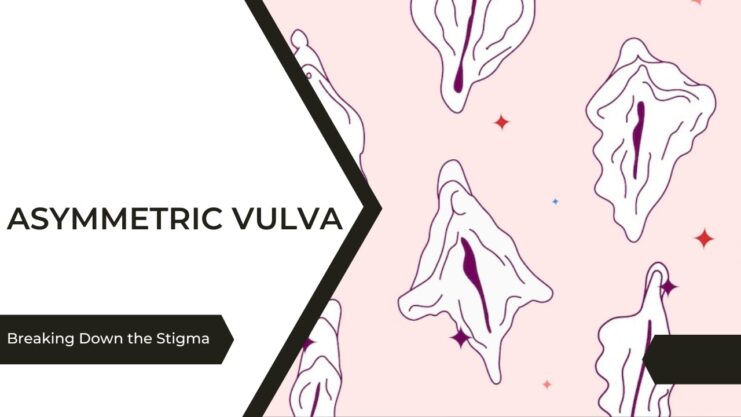It’s not every day that you take a moment to really look at your own body, especially the more intimate parts like your genitals. But on one of those rare occasions, you might notice something that you hadn’t before – one side of your labia minora, those delicate inner folds nestled within the larger outer folds known as the labia majora, is a bit larger than the other.
First and foremost, take a deep breath and let go of any stress or worry. This is completely normal. Each woman’s body is unique, and that includes the intimate areas as well. It’s actually quite rare to find perfectly symmetrical labia minora. More often than not, one side will be slightly larger or longer than the other. You might even notice that they extend beyond the outer lips.
Remember, these variations are part of what makes each of us unique and beautiful in our own way. It’s a testament to the diversity of the human body and a reminder that there’s no such thing as “normal” when it comes to our individual shapes and sizes. So, instead of worrying about these differences, embrace them as part of what makes you, you.
When does this become a problem?
When the inner flaps are way much longer than the outer ones or asymmetry is obvious, cleanliness of the area can be difficult to maintain. Urinary stream becomes disrupted, itching and swelling are frequently experienced, wearing tight clothes can cause pain, and sexual intercourse can be painful. Some women tend to be disgusted by the appearance and have lesser self-confidence when it comes to sex.
What to do?

When there is infection, swelling, itching and redness is observed. A burning sensation may be felt during urination. Such discomfort can prolong for as long as a week or so if untreated. Topical antibiotics and anti-histamine creams often give relief. Moisture is the main cause that aggravates the condition, so it’s best to keep the area clean and dry. If this doesn’t resolve or instead worsens, talk to your doctor.
A severe degree of flap elongation may lead to the necessity of surgical repair. Pain and discomfort during sex and when wearing panties, and frequent episodes of infection are some of the main reasons to consider surgery. Some self-conscious women opt for what is called labioplasty (lip repair) for cosmetic reasons.
In short, one needs to note that it is perfectly normal to have asymmetric labial lips. This condition is deemed worrisome only when infections or sexual dysfunction set in.
Psychological Impact
The appearance of one’s genitals can have a significant psychological impact, particularly in a society that often perpetuates unrealistic standards of beauty. Women with asymmetrical labia minora may experience feelings of self-consciousness, embarrassment, or even anxiety, especially in intimate situations.
It’s important to remember that every body is unique and there’s no “right” or “wrong” way to look. Embracing body positivity and self-acceptance can help combat these negative feelings. If these feelings persist, it may be beneficial to seek support from a mental health professional.
Prevention Measures
Maintaining good hygiene is crucial in preventing infections or discomfort in the genital area. This includes regular washing with mild, unscented soap and water, and drying the area thoroughly afterwards. Wearing breathable, cotton underwear can also help prevent moisture build-up, which can lead to infections. Avoid using irritating products, such as scented wipes or douches, as these can disrupt the natural balance of bacteria in the vagina and cause irritation.
Medical Consultation
If you’re experiencing persistent discomfort, pain, or recurrent infections, it’s important to consult a healthcare professional. During a consultation, you can expect a physical examination and possibly some tests to rule out any underlying conditions. You should feel free to ask any questions you have, such as what could be causing your symptoms, what treatment options are available, and what you can do to prevent future issues.
Alternative Treatments
For those who are experiencing discomfort or self-consciousness but do not wish to undergo surgery, there are alternative treatments available. Therapy or counseling can help address feelings of anxiety or low self-esteem. Pelvic floor exercises can improve muscle tone and reduce discomfort. There are also products designed for intimate comfort, such as lubricants or moisturizers, which can help alleviate dryness or irritation.
Myths and Misconception
There are many myths and misconceptions surrounding labial size and symmetry. For example, some people believe that larger or asymmetrical labia are the result of frequent sexual activity, but this is not true. Labial size and shape are determined by genetics and hormonal changes, not sexual behavior.
Another common misconception is that most women have perfectly symmetrical labia, when in fact, asymmetry is very common. It’s important to dispel these myths and promote a more positive and realistic view of female genitalia.
Final Words
In conclusion, it’s essential to remember that every woman’s body is unique, and this includes the intimate areas as well. Asymmetrical labia minora is a common occurrence and is not indicative of any abnormality or health issue. However, if this asymmetry leads to physical discomfort, recurrent infections, or psychological distress, it’s important to seek medical advice.
There are various treatment options available, ranging from maintaining good hygiene and using comfort-enhancing products to therapeutic interventions and even surgical procedures in severe cases. It’s crucial to dispel myths and misconceptions about labial size and symmetry, as these can contribute to unnecessary anxiety and self-consciousness.
Related Posts:
- Can I Use Any Coaxial Cable For The Internet? -…
- How to Deal with Fordyce Spots on the Vulva - Say…
- The Meaning Behind the Upside-Down Pineapple: More…
- The Low Down on Viagra, Cialis and Levitra: Choosing…
- Vaginal Itching: A Common Problem of The Young and Old
- 10 Proven Ways to Fix the No Bootable Device Acer…












